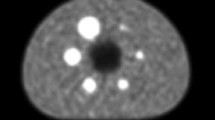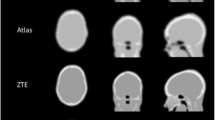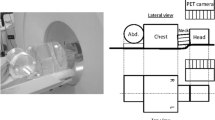Abstract
Purpose
Image reconstruction including the modelling of the point spread function (PSF) is an approach improving the resolution of the PET images. This study assessed the quantitative improvements provided by the implementation of the PSF modelling in the reconstruction of the PET data using the High Resolution Research Tomograph (HRRT).
Methods
Measurements were performed on the NEMA-IEC/2001 (Image Quality) phantom for image quality and on an anthropomorphic brain phantom (STEPBRAIN). PSF reconstruction was also applied to PET measurements in two cynomolgus monkeys examined with [18F]FE-PE2I (dopamine transporter) and with [11C]MNPA (D2 receptor), and in one human subject examined with [11C]raclopride (D2 receptor).
Results
PSF reconstruction increased the recovery coefficient (RC) in the NEMA phantom by 11–40% and the grey to white matter ratio in the STEPBRAIN phantom by 17%. PSF reconstruction increased binding potential (BP ND) in the striatum and midbrain by 14 and 18% in the [18F]FE-PE2I study, and striatal BP ND by 6 and 10% in the [11C]MNPA and [11C]raclopride studies.
Conclusion
PSF reconstruction improved quantification by increasing the RC and thus reducing the partial volume effect. This method provides improved conditions for PET quantification in clinical studies with the HRRT system, particularly when targeting receptor populations in small brain structures.






Similar content being viewed by others
References
de Jong HW, van Velden FH, Kloet RW, Buijs FL, Boellaard R, Lammertsma AA. Performance evaluation of the ECAT HRRT: an LSO-LYSO double layer high resolution, high sensitivity scanner. Phys Med Biol 2007;52:1505–26. doi:10.1088/0031-9155/52/5/019.
Heiss WD, Habedank B, Klein JC, Herholz K, Wienhard K, Lenox M, et al. Metabolic rates in small brain nuclei determined by high-resolution PET. J Nucl Med 2004;45:1811–5.
Horti AG, Fan H, Kuwabara H, Hilton J, Ravert HT, Holt DP, et al. 11C-JHU75528: a radiotracer for PET imaging of CB1 cannabinoid receptors. J Nucl Med 2006;47:1689–96.
Leroy C, Comtat C, Trébossen R, Syrota A, Martinot JL, Ribeiro MJ. Assessment of 11C-PE2I binding to the neuronal dopamine transporter in humans with the high-spatial-resolution PET scanner HRRT. J Nucl Med 2007;48:538–46. doi:10.2967/jnumed.106.037283.
Hirvonen J, Johansson J, Teräs M, Oikonen V, Lumme V, Virsu P, et al. Measurement of striatal and extrastriatal dopamine transporter binding with high-resolution PET and [(11) C]PE2I: quantitative modeling and test-retest reproducibility. J Cereb Blood Flow Metab 2008;28:1059–69. doi:10.1038/sj.jcbfm.9600607.
Panin VY, Kehren F, Michel C, Casey M. Fully 3-D PET reconstruction with system matrix derived from point source measurements. IEEE Trans Med Imaging 2006;25:907–21. doi:10.1109/TMI.2006.876171.
Sureau FC, Reader AJ, Comtat C, Leroy C, Ribeiro MJ, Buvat I, et al. Impact of image-space resolution modeling for studies with the high-resolution research tomograph. J Nucl Med 2008;49:1000–8. doi:10.2967/jnumed.107.045351.
Quarantelli M, Berkouk K, Prinster A, Landeau B, Svarer C, Balkay L, et al. Integrated software for the analysis of brain PET/SPECT studies with partial-volume-effect correction. J Nucl Med 2004;45:192–201.
Rousset OG, Ma Y, Evans AC. Correction for partial volume effects in PET: principle and validation. J Nucl Med 1998;39:904–11.
Rousset OG, Deep P, Kuwabara H, Evans AC, Gjedde AH, Cumming P. Effect of partial volume correction on estimates of the influx and cerebral metabolism of 6-[(18) F]fluoro-L-dopa studied with PET in normal control and Parkinson’s disease subjects. Synapse 2000;37:81–9. doi:10.1002/1098-2396(200008) 37:2<81::AID-SYN1>3.0.CO;2-#.
Müller-Gärtner HW, Links JM, Prince JL, Bryan RN, McVeigh E, Leal JP, et al. Measurement of radiotracer concentration in brain gray matter using positron emission tomography: MRI-based correction for partial volume effects. J Cereb Blood Flow Metab 1992;12:571–83.
Hong IK, Chung ST, Kim HK, Kim YB, Son YD, Cho ZH. Ultra fast symmetry and SIMD-based projection-backprojection (SSP) algorithm for 3-D PET image reconstruction. IEEE Trans Med Imaging 2007;26:789–803. doi:10.1109/TMI.2007.892644.
Comtat C, Sureau FC, Sibomana M, Hong IK, Sjöholm N, Trébossen R. Image based resolution modeling for the HRRT OSEM reconstructions software. Paper presented at: IEEE Nuclear Science Symposium Conference Record, 2008; Dresden, Germany.
Joseph PM. An improved algorithm for reprojecting rays through pixel images. IEEE Trans Med Imaging 1982;1:192–6. doi:10.1109/TMI.1982.4307572.
Daube-Witherspoon ME, Karp JS, Casey ME, DiFilippo FP, Hines H, Muehllehner G, et al. PET performance measurements using the NEMA NU 2–2001 standard. J Nucl Med 2002;43:1398–409.
Reilhac A, Tomeï S, Buvat I, Michel C, Keheren F, Costes N. Simulation-based evaluation of OSEM iterative reconstruction methods in dynamic brain PET studies. Neuroimage 2008;39:359–68. doi:10.1016/j.neuroimage.2007.07.038.
Alfano B, Prinster A, Quarantelli M, Brunetti A, Salvatore M. STEPBRAIN: A stereolitographed phantom of the brain for nuclear medicine, computed tomography, and magnetic resonance applications. Paper presented at: RSNA, 2003.
Odano I, Halldin C, Karlsson P, Varrone A, Airaksinen AJ, Krasikova RN, et al. [(18)F]Flumazenil binding to central benzodiazepine receptor studies by PET—quantitative analysis and comparisons with [(11)C]flumazenil. Neuroimage 2009;45:891–902.
Clark JD, Gebhart GF, Gonder JC, Keeling ME, Kohn DF. Special Report: The 1996 Guide for the Care and Use of Laboratory Animals. ILAR J 1997;38:41–8.
Varrone A, Steiger C, Schou M, Takano A, Finnema SJ, Guilloteau D, et al. In vitro autoradiography and in vivo evaluation in cynomolgus monkey of [18F]FE-PE2I, a new dopamine transporter PET radioligand. Synapse. 2009; In press.
Finnema SJ, Seneca N, Farde L, Shchukin E, Sóvágó J, Gulyás B, et al. A preliminary PET evaluation of the new dopamine D2 receptor agonist [11C]MNPA in cynomolgus monkey. Nucl Med Biol 2005;32:353–60. doi:10.1016/j.nucmedbio.2005.01.007.
Karlsson P, Farde L, Halldin C, Swahn CG, Sedvall G, Foged C, et al. PET examination of [11C]NNC 687 and [11C]NNC 756 as new radioligands for the D1-dopamine receptor. Psychopharmacology (Berl) 1993;113:149–56. doi:10.1007/BF02245691.
Lammertsma AA, Hume SP. Simplified reference tissue model for PET receptor studies. Neuroimage 1996;4:153–8. doi:10.1006/nimg.1996.0066.
Farde L, Hall H, Ehrin E, Sedvall G. Quantitative analysis of D2 dopamine receptor binding in the living human brain by PET. Science 1986;231:258–61. doi:10.1126/science.2867601.
Bergström M, Boëthius J, Eriksson L, Greitz T, Ribbe T, Widén L. Head fixation device for reproducible position alignment in transmission CT and positron emission tomography. J Comput Assist Tomogr 1981;5:136–41. doi:10.1097/00004728-198102000-00027.
Roland PE, Graufelds CJ, Wahlin J, Ingelman L, Andersson M, Ledberg A, et al. Human brain atlas: for high-resolution functional and anatomical mapping. Hum Brain Mapp 1994;1:173–84. doi:10.1002/hbm.460010303.
Giovacchini G, Toczek MT, Bonwetsch R, Bagic A, Lang L, Fraser C, et al. 5-HT 1A receptors are reduced in temporal lobe epilepsy after partial-volume correction. J Nucl Med 2005;46:1128–35.
Hasselbalch SG, Madsen K, Svarer C, Pinborg LH, Holm S, Paulson OB, et al. Reduced 5-HT2A receptor binding in patients with mild cognitive impairment. Neurobiol Aging 2008;29:1830–8. doi:10.1016/j.neurobiolaging.2007.04.011.
Acknowledgments
The authors would like to thank members of the Karolinska Institutet PET Centre for assistance in the PET experiments. The authors also thank Drs. Inki Hong and Merence Sibomana for implementation of the PSF modelling in the fast reconstruction software, and Dr. Bruno Alfano for providing the STEPBRAIN phantom.
This study was presented in abstract form at the Neuroreceptor Mapping 2008 Meeting, Pittsburgh, PA, USA, and at the European Association of Nuclear Medicine 2008 Congress, Munich, Germany. This study was funded in part by the EC - FP6-project DiMI, LSHB-CT-2005-512146 and by VR Swedish Science Council 48105.
Author information
Authors and Affiliations
Corresponding author
Rights and permissions
About this article
Cite this article
Varrone, A., Sjöholm, N., Eriksson, L. et al. Advancement in PET quantification using 3D-OP-OSEM point spread function reconstruction with the HRRT. Eur J Nucl Med Mol Imaging 36, 1639–1650 (2009). https://doi.org/10.1007/s00259-009-1156-3
Received:
Accepted:
Published:
Issue Date:
DOI: https://doi.org/10.1007/s00259-009-1156-3




